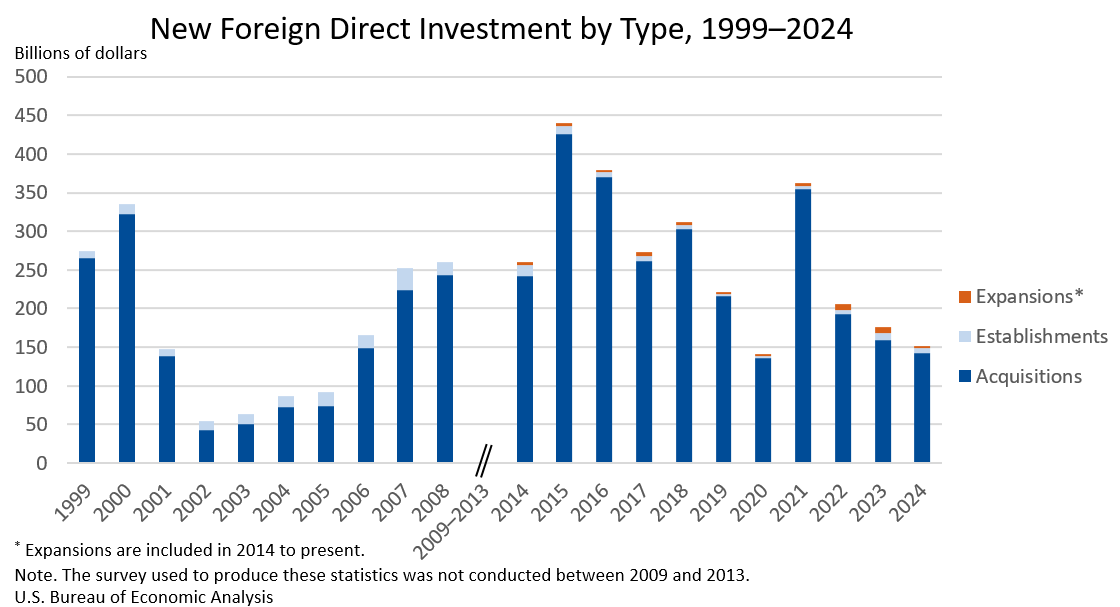Bureau of Economic Analysis
New Foreign Direct Investment in the United States, 2024
Expenditures by foreign direct investors to acquire, establish, or expand U.S. businesses totaled $151.0 billion in 2024, according to preliminary statistics released today by the U.S. Bureau of Economic Analysis. Expenditures decreased $24.9 billion, or 14.2 percent, from $176.0 billion (revised) in 2023 and were below the annual average of $277.2 billion for 2014–2023. As in previous years, acquisitions of existing U.S. businesses accounted for most of the expenditures.
Principal Federal Economic Indicators
Noteworthy
- 2025 News Release Schedule
- Innovation at BEA
- 2025 Annual Updates
- New! Services Trade Data for More Countries
- Data Tool: Trade in Value Added
- Distribution of State Personal Income
- Updated: RIMS II Regional Multipliers
- Arts and Culture
- Space Economy
- FDI Now in State BEARFACTS
- Quick Guide: Price Indexes
The Latest
Personal Income and Outlays, May 2018
Personal income increased $60.0 billion (0.4 percent) in May according to estimates released today by the Bureau of Economic Analysis. Disposable personal income (DPI) increased $63.2 billion (0.4 percent) and personal consumption expenditures (PCE) increased $27.8 billion (0.2 percent).
GDP Increases in First Quarter
Real gross domestic product (GDP) increased 2.0 percent in the first quarter of 2018, according to the “third” estimate released by the Bureau of Economic Analysis. The growth rate was 0.2 percentage point lower than the “second” estimate released last month. In the fourth quarter of 2017, real GDP increased 2.9 percent.
Gross Domestic Product: First Quarter 2018 (Third Estimate)
Real gross domestic product (GDP) increased at an annual rate of 2.0 percent in the first quarter of 2018 (table 1), according to the "third" estimate released by the Bureau of Economic Analysis. In the fourth quarter, real GDP increased 2.9 percent.
U.S. Net International Investment Position First Quarter 2018
The U.S. net international investment position decreased to −$7,888.1 billion (preliminary) at the end of the first quarter of 2018 from −$7,725.0 billion (revised) at the end of the fourth quarter of 2017. The $163.1 billion decrease reflected net financial transactions of –$164.8 billion and net other changes in position, such as price and exchange-rate changes, of $1.7 billion.
U.S. Net International Investment Position First Quarter 2018
The U.S. net international investment position decreased to −$7,888.1 billion (preliminary) at the end of the first quarter of 2018 from −$7,725.0 billion (revised) at the end of the fourth quarter of 2017. The $163.1 billion decrease reflected net financial transactions of –$164.8 billion and net other changes in position, such as price and exchange-rate changes, of $1.7 billion.
U.S. International Investment Position, 1st quarter 2018, Year 2017, and annual update
The U.S. net international investment position decreased to -$7,888.1 billion (preliminary) at the end of the first quarter of 2018 from -$7,725.0 billion (revised) at the end of the fourth quarter of 2017, according to statistics released by the Bureau of Economic Analysis (BEA). The $163.1 billion decrease reflected a $182.8 billion decrease in U.S. assets and a $19.7 billion decrease in U.S. liabilities.
State Personal Income: First Quarter 2018
State personal income increased 4.3 percent at an annual rate in the first quarter of 2018, after increasing 4.7 percent in the fourth quarter of 2017. Personal income increased in all states and the District of Columbia. The percent change in personal income across all states ranged from 7.4 percent in Washington to 2.0 percent in Idaho.
State Quarterly Personal Income, 1st quarter 2018
State personal income increased 4.3 percent at an annual rate in the first quarter of 2018, after increasing 4.7 percent in the fourth quarter of 2017, according to estimates released today by the Bureau of Economic Analysis1 (table 1). Personal income increased in all states and the District of Columbia. The percent change in personal income across all states ranged from 7.4 percent in Washington to 2.0 percent in Idaho.
U.S. Current-Account Deficit Increases in First Quarter 2018
The U.S. current-account deficit increased to $124.1 billion (preliminary) in the first quarter of 2018 from $116.1 billion (revised) in the fourth quarter of 2017. As a percentage of U.S. GDP, the deficit increased to 2.5 percent from 2.4 percent. The previously published current-account deficit for the fourth quarter was $128.2 billion.
U.S. International Transactions, 1st quarter 2018 and annual update
The U.S. current-account deficit increased to $124.1 billion (preliminary) in the first quarter of 2018 from $116.1 billion (revised) in the fourth quarter of 2017, according to statistics released by the Bureau of Economic Analysis (BEA). The deficit was 2.5 percent of current-dollar gross domestic product (GDP) in the first quarter, up from 2.4 percent in the fourth quarter.




